Russians 'using banned "butterfly mines" to kill and maim Ukrainians'
Russian forces appear to be using ‘butterfly mines’ to injure and kill Ukrainians as photos show the little bombs scattered around a town.
The explosives – banned under international law – look a bit like toys but can be deadly if activated.
They tend to be dropped en masse from rockets, mortars or aircraft and glide to the ground without exploding. They then blow up with as little as 5kg of pressure.
Photos released to The Sun by the Halo Trust, a mine clearance organisation once backed by Princess Diana, show a number of the mines scattered around the town of Hrakove, near Kharkiv in north-east Ukraine.
The bombs, officially called PFM-1 mines, can be spotted hidden in the grass, scattered on park benches and lying by the side of the road.
Because of their plastic shape and small size, it’s feared children will pick them up thinking they’re toys.
Members of the Halo Trust are now desperately working to clear the area, a process which will probably take years to complete.
Ukrainian authorities say a number of people, including five children, have already lost limbs to the explosives, also known as petal mines because of their shape.
It’s understood Russian forces dropped the mines in the area last year to cover their retreat.
Banderivka – not her real name – is a deminer from Lviv. She said: ‘Soldiers and civilians are still getting injured by these mines. The Russians sometimes cover them up as they retreat so we don’t even see them.’
‘When you see one, you know there around another 700 of them around you.’
To view this video please enable JavaScript, and consider upgrading to a webbrowser thatsupports HTML5video
‘The worst thing about them is kids are drawn to them – they look like a plastic toy on the ground – and sometimes they pick them up.’
She said Ukrainian troops often use low-tech solutions to clear the mines, such as shooting them or throwing something at them.
Benderivka urged the West to put pressure on Russia to stop using devices like the butterfly mine.
Ukraine signed up to the Ottawa Treaty banning the mines and Russia declared war said it would scrap its stockpile – something Russia has been unwilling to do.
The Kremlin has accused Ukraine of using the explosives in the breakaway region of Donetsk, something Kyiv has denied.
Most of the bombs, many decades old, were manufactured in the former Soviet Union making it hard to determine who dropped them.
A village in southern Ukraine called Mykolaiv that was once home to thousands of people had to be evacuated after the mines were left scattered around the area, according to the Halo Trust. Only 150 people remain.
Paul McCann, the Halo Trust’s communications director, said the butterfly mines remain explosive for a long time.
Live ones are still being found in Afghanistan, he explained, putting innocent civilians at risk years after the war ended.
He told the Sun his colleagues at the NGO often say: ‘One day of fighting amounts to a month of mine clearance.’
Clearing the explosives across Ukraine will cost about £30 billion, according to the World Bank.
But Paul said if the international community comes together to cover some of the costs, they can use drones and remote armoured vehicles to get the job done safely.
Get in touch with our news team by emailing us at [email protected].
For more stories like this, check our news page.
Source: Read Full Article




